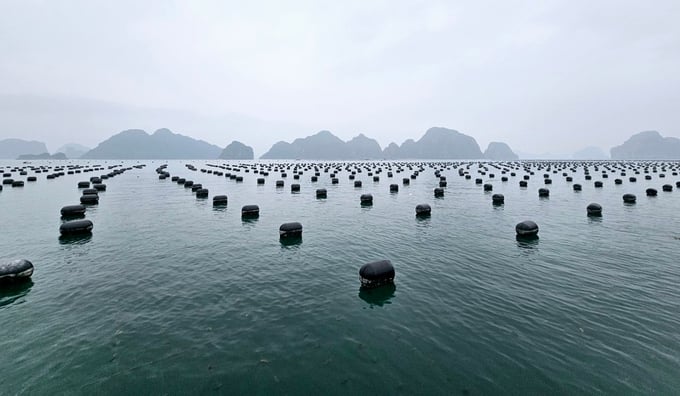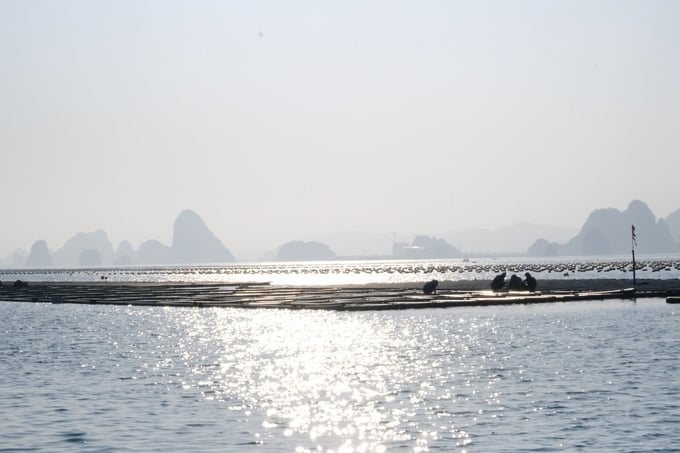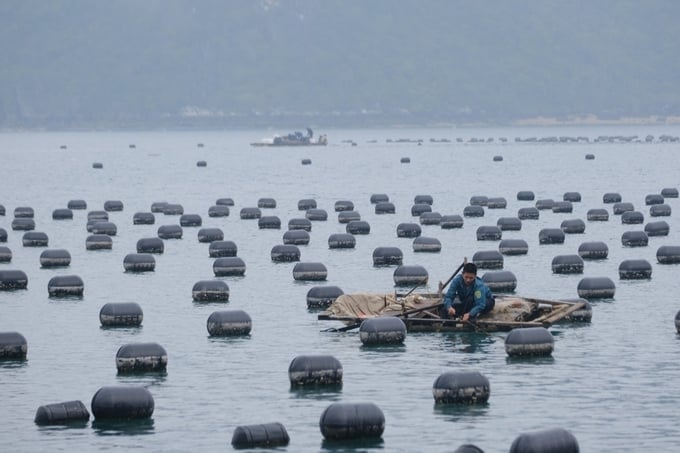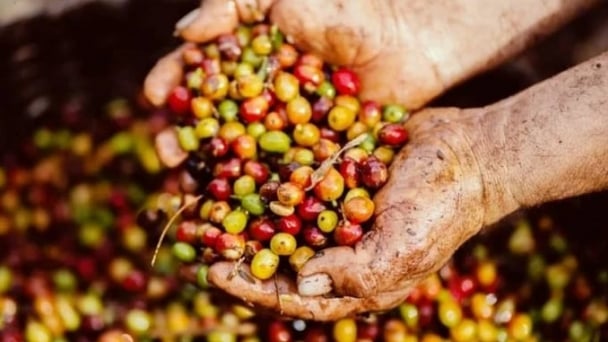June 17, 2025 | 21:06 GMT +7
June 17, 2025 | 21:06 GMT +7
Hotline: 0913.378.918
June 17, 2025 | 21:06 GMT +7
Hotline: 0913.378.918

Quang Ninh aspires to become a center for mariculture. Photo: Hoang Anh.
Quang Ninh province possesses significant potential and advantages in developing its mariculture industry. With a coastline stretching 250 kilometers from Mong Cai to Quang Yen, featuring Ha Long Bay, Bai Tu Long Bay; over two thousand islands, which account for more than two-thirds of the country's total number of islands; over 40,000 hectares of tidal flats and 20,000 hectares of sea straits and bays; over 6,100 square kilometers of fishing grounds and 45,000 hectares of mariculture area, Quang Ninh is positioned to become the largest mariculture center in northern Vietnam.
Quang Ninh's fisheries sector has held a pivotal role in the province's development over the last few years, accounting for over 55% of the province's total agricultural, forestry, and fisheries production value. In compliance with Vietnam's marine and fisheries development strategies, the province has implemented various policies aimed at creating a stable foundation for the development of its fisheries sector towards increasing value added and maintaining sustainable growth.
As a result, Quang Ninh's fisheries yield increased from 88,984 tons in 2013 to 175,324 tons in 2023. Moreover, the province's concentrated aquaculture areas have expanded both in scale and production output, with a total area of 32,092 hectares, representing an increase of 10,667 hectares compared to 2013.
According to statistics, Quang Ninh province currently houses 16 production and supply facilities for aquatic seeds, supplying approximately 3 billion seeds to both domestic and international markets annually. With a fleet of 5,556 fishing vessels, the province has implemented the consistent strategy of "reducing fishing, increasing aquaculture," resulting in a gradual reduction in offshore fishing vessels and a rapid decline in nearshore fishing vessels.
The local government has also effectively organized efforts to protect aquatic resources and manage mariculture. Furthermore, several major investors have focused on infrastructure development for seed production and concentrated aquaculture areas.

The integrated pacific oyster and elkhorn sea moss farming model in Van Don yields significant economic value. Photo: Hoang Anh.
By identifying investment attraction as a decisive factor in developing the mariculture sector, Quang Ninh Province has formulated a strategy focusing on introducing and analyzing the province's nine advantages for mariculture development. Additionally, it has committed to accompanying the business community in developing the mariculture sector and the maritime economy as a whole.
Quang Ninh's first advantage lies in its exceptional level of competitiveness compared to other provinces and cities nationwide. Both the local government and the community are committed to fully utilizing the potential of the sea.
Quang Ninh is focusing on administrative reform, minimizing the time required for investment procedures, expediting land clearance and compensation processes, and optimizing investors' access to land.
Secondly, Quang Ninh holds a strategically important economic and political position with outstanding advantages. Its trade activities and import-export operations benefit considerably from its convenient location within the "Two Corridors, One Economic Belt" cooperation area between Vietnam and China, the interregional cooperation in the Gulf of Tonkin, and the Nanning-Singapore Economic Corridor. Notably, the province serves as a crucial bridge in ASEAN-China economic cooperation.
These factors are considered unique potentials and advantages for attracting investment in mariculture and the establishment of processing plants.

A new day in the mariculture area in Quang Ninh province. Photo: Hoang Anh.
Thirdly, Quang Ninh province boasts a large area with abundant natural resources and a diverse natural ecosystem, featuring both sea and forest landscapes, in addition to various world-renowned natural heritage sites.
Fourthly, Quang Ninh's transportation infrastructure is comprehensive, modern, and rapidly developing. Its well-established road, air, and sea transportation networks serve as significant potentials and advantages for the development of mariculture as well as the maritime economy as a whole.
Fifthly, the economic structure of Quang Ninh province is gradually shifting to adapt to modern global trends. Accordingly, the service and tourism sectors will be developed as an entertainment industry.
Sixthly, the province maintains a strong public order and social security. Quang Ninh also collaborates with universities and research institutions to train human resources for mariculture, with a focus on training high-quality personnel to meet the needs of mariculture investors in Quang Ninh.
Seventhly, Quang Ninh has positioned fisheries as a key economic sector, with central policies acknowledging its status as the center for fisheries in northern Vietnam. With over 6,000 square kilometers of sea area and 45,000 hectares of mariculture area, accounting for over 15% of the national mariculture area, Quang Ninh province has identified mariculture development as a key economic focus.
Eighthly, Quang Ninh has established comprehensive legal frameworks to support the development of the fisheries sector. The province is a pioneer in planning and issuing policies for mariculture to create a stable foundation for the development of its fisheries sector towards increasing value added and maintaining sustainable growth.
Notably, Quang Ninh recently restructured its fisheries sector towards reducing fishing activities and increasing mariculture; transitioning from foam buoys to environmentally friendly HDPE buoys.
Ninthly, local production activities in mariculture and the maritime economy are receiving continuous investment for expansion. The local government is engaged in building mariculture value chains, promoting investment in processing, market development, fishing logistics, establishing co-management models, training, applying scientific breakthroughs, and cooperating in mariculture development.

With a total area of 13,421 hectares, Quang Ninh province has remarkable potential and opportunities for the development of the mariculture industry. Photo: Hoang Anh.
In order to attract investment in mariculture, Quang Ninh province's Department of Agriculture and Rural Development has finalized the investment attraction documentation for mariculture in the province, This documentation indicates that the total area of investment attraction for mariculture in Quang Ninh is 13,421 hectares. Quang Yen town will be the first region to approve a mariculture project with an investment attraction area of 865 hectares. Other regions including Mong Cai with 3,625 hectares, Hai Ha with 743 hectares, Dam Ha with 1,200 hectares, Van Don with 4,800 hectares, Co To with 1,500 hectares, Cam Pha with 1,433 hectares, etc., have been planned in depth, featuring designated areas for mariculture, and detailed analysis of the potential and advantages to attract investors in mariculture.
With the aim of developing the fistheries sector in an ecological, green, and clean direction, and developing modern production processes by utilizing the potential and advantages of the sea and islands, Quang Ninh aims to develop towards modernity and sustainability by 2030. The local government is committed to fostering a favorable environment for investors, with a focus on investors with advanced scientific and technological expertise in mariculture.
The Ministry of Agriculture and Rural Development and Quang Ninh province will organize the "Sustainable Mariculture Development Conference - Insights from Quang Ninh" on April 1. The conference is chaired by Minister of Agriculture and Rural Development Le Minh Hoan and the Secretary of the Provincial Party Committee and Chairman of the Provincial People's Council of Quang Ninh province Nguyen Xuan Ky. The conference is expected to attract 400 to 450 domestic and international participants.
The event will be broadcast live by the Vietnam Agriculture Newspaper on multiple media platforms.
You can participate in the conference via Zoom ID: 939 8269 4473; Password: 202404.
Translated by Nguyen Hai Long
![Turning wind and rain into action: [7] Early disaster warnings help marine farmers minimize losses](https://t.ex-cdn.com/nongnghiepmoitruong.vn/608w/files/news/2025/06/17/z6704423696987_15fd32ffc26d590d204d520c9dac6786-nongnghiep-142942.jpg)
(VAN) In recent years, thanks to early disaster warnings and forecasting, marine farmers in Khanh Hoa province have been able to reduce risks and losses, thereby improving production efficiency.
![Turning wind and rain into action: [5] Hue applies modern technology in disaster forecasting](https://t.ex-cdn.com/nongnghiepmoitruong.vn/608w/files/news/2025/06/17/z6704423696987_15fd32ffc26d590d204d520c9dac6786-nongnghiep-093938.jpg)
(VAN) In Hue city, modern technology has recently been applied in meteorological and hydrological forecasting and warning, helping to reduce the damage caused by natural disasters.

(VAN) A cutting-edge farming technique being implemented on an experimental ranch in Arizona's Sonoran Desert has already saved a billion gallons of water over five years, according to Civil Eats.

(VAN) Poultry and pig production and the environment can be boosted through enhanced water technology, according to new research.

(VAN) Coffee prices on June 16, 2025 are unchanged. In Vietnam, local trading prices are holding steady, ranging around VND 112,000 – VND 112,500/kg.
![Turning wind and rain into action: [4] Bringing climate bulletins to remote and isolated areas](https://t.ex-cdn.com/nongnghiepmoitruong.vn/608w/files/linhnhp/2025/06/14/1152-z6704423696987_15fd32ffc26d590d204d520c9dac6786-nongnghiep-151141.jpg)
(VAN) The Vietnam Agriculture and Nature Newspaper interviewed Mr. Vu Thai Truong, Acting Head of Climate Change and Environment at UNDP Vietnam, to gain deeper insight into how climate bulletins are delivered to farmers.

(VAN) In Tien Giang, a high-tech shrimp farm has developed a distinctive energy-saving farming model that has yielded promising results.